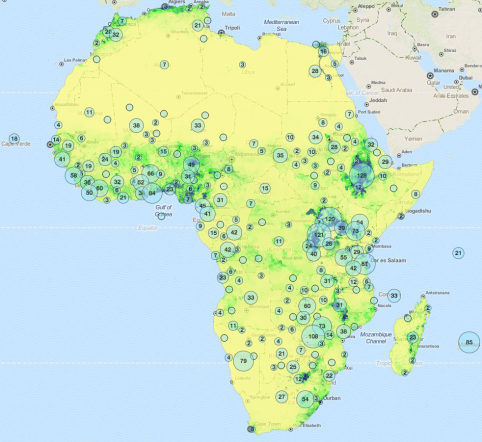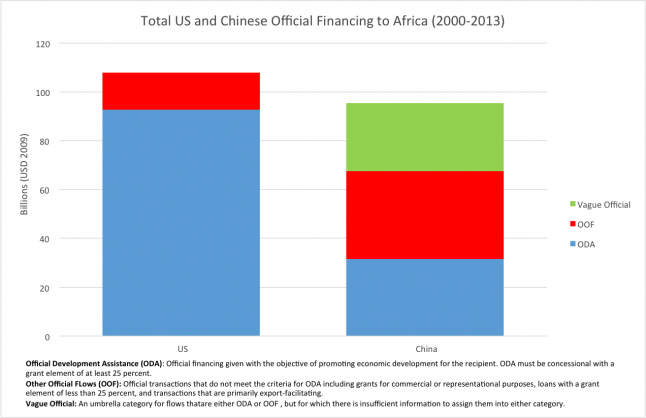Western pundits have a narrative about China’s activities in Africa. It goes something like this: China now provides as much, if not more, aid to Africa as the United States. Much of this aid goes to corrupt and authoritarian regimes. Beijing’s main goal is to buy the loyalty of Africa’s governing elites and secure access to the continent's rich natural resources.
U.S. and European policymakers have seized on this narrative. For instance, during a July 2015 trip to Africa, President Obama mentioned that China has “been able to funnel an awful lot of money into Africa, basically in exchange for raw materials that are being extracted from Africa.” He sought to differentiate the United States from China, noting that “economic relationships can’t simply be about building countries’ infrastructure with foreign labor or extracting Africa’s natural resources.”
But is this narrative true?
In a new AidData working paper entitled "Apples and Dragon Fruits: The Determinants of Aid and Other Forms of State Financing from China to Africa," we argue against it. It’s true that China and other governments provide many different types of state financing to African nations. But only those flows that the OECD considers to be official development assistance (ODA) should be considered “aid” in a strict sense. That may seem to be a fine distinction but it matters. We propose that China has very different motivations for providing its various sources of financial support to other countries. We test our hypothesis using AidData’s open source database of Chinese development funding across Africa (see Figure 1) between 2000 and 2013.

Figure 1: The geographic distribution of Chinese official finance projects to Africa, 2000-2012. Circle size indicates the number of projects committed to a particular sub-national region. Source: http://china.aiddata.org/.
Our paper punctures several of the most popular and persistent claims about Chinese development finance.
Take for example the claim that Chinese “aid” is funneled primarily to corrupt and authoritarian regimes and motivated by China’s insatiable appetite for natural resources. We find no evidence that China favors authoritarian or corrupt regimes (so-called "rogue states”) when it allocates official development assistance (ODA). Nor does China seem to take natural resource considerations into account when committing ODA to African states.
Instead, we find that Chinese ODA to Africa is strongly oriented towards poorer countries. Beijing seems to consider demand-side humanitarian and socioeconomic needs when making ODA allocation decisions. We also find evidence that China rewards foreign policy support from its aid recipients. These findings, when taken together, suggest that Chinese ODA allocation practices are much like those of Western donors.
By contrast, more commercially-oriented forms of Chinese state financing, with higher interest rates and lower grant elements, (known in the trade as “other official flows,” or OOF) tend to go to countries rich in natural resources and with higher levels of corruption.
That’s why pundits and policymakers labor under the false presumption that Chinese “aid” flows to rogue states that are resource-rich. Chinese ODA doesn’t disproportionately flow to such countries. What does are other forms of state financing, not “aid” in the traditional sense. Previous empirical research (discussed on this blog and elsewhere) had suggested that the “rogue donor” narrative was overblown, but the inability to distinguish between ODA and OOF ultimately gave it staying power.
Our findings have important implications for those who wish to improve the effectiveness of aid. Given that China’s aid-giving has a reasonably strong philanthropic element and the impact of aid depends in part on a donor’s motive for providing it, there are some grounds for optimism about China’s ability to improve economic and social outcomes in the developing world. But this is not the only reason why Western powers should welcome rather than fear more aid from Beijing. As Western donors and China realize that their similarities are greater than their differences, they may find it easier to work towards a common aim: limiting the negative consequences of fragmented and un-coordinated aid.
Another popular claim is the notion that China now provides as much, or more, aid to Africa than the United States. Again, it’s not so. China committed approximately $31.5 billion of ODA to Africa between 2000 and 2013, or approximately $2.25 billion per year, according to our analysis of AidData’s Chinese Official Finance to Africa dataset.
By comparison, the United States committed nearly three times as much ODA to Africa over the same period of time: $92.7 billion from 2000 to 2013, or approximately $6.62 billion per year (see Figure 2).
When we broaden the analysis beyond ODA to include less concessional “other official financing” (OOF), we find that China and the United States provide comparable levels of funding to Africa. We estimate that China and the United States committed $94.3 billion and $107.9 billion of total official financing to Africa, respectively, between 2000 and 2013.

Figure 2: Total U.S. and Chinese Official Financing Commitments to Africa (in constant US$) from 2000-2013, by Flow Class. Sources: http://china.aiddata.org/ and http://stats.oecd/qwids/
Why has it taken so long to establish these facts? One reason: China’s government discloses few details about its overseas development efforts. Another is that researchers have developed idiosyncratic measurement standards for defining and counting Chinese “aid” that make it hard to do apples-to-apples comparisons with Western development finance. A lack of transparency in the data and the methods that researchers use to draw conclusionshas also created confusion rather than clarity.
Our findings help explain why pundits and policymakers continue to mischaracterize the intent and nature of Chinese development finance. We hope that by entering a new source of evidence into the public record, apples will be compared to apples, and dragon fruits will be compared to dragon fruits, so that Chinese development finance is evaluated on its merits rather than the ideological commitments, political interests, or biased samples used by the various critics and defenders of Beijing’s activities in Africa.


